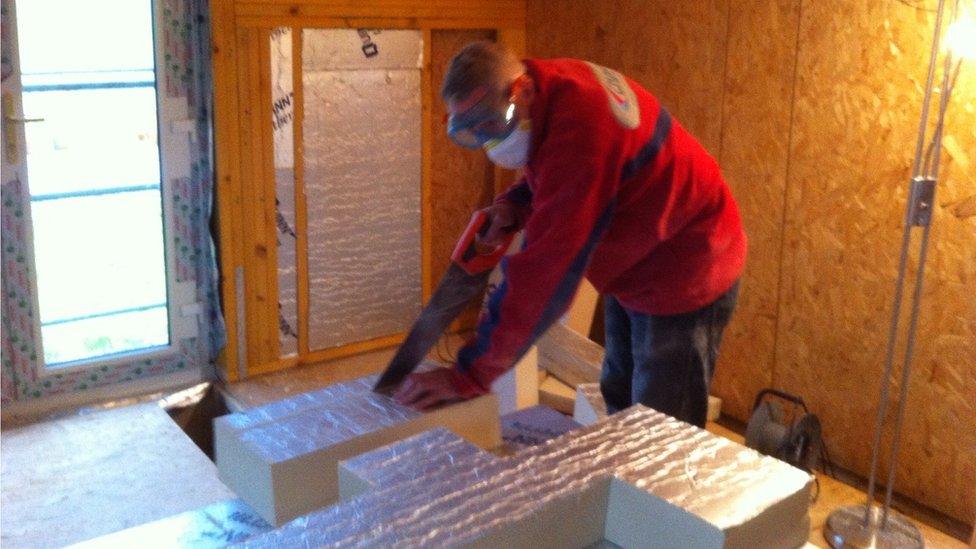The house that keeps its secrets buried
- Published

The house in rural Ayrshire does little to advertise the innovative technology it employs
This is a house that keeps most of its secrets buried.
From many angles, it is little different from many of those near it in a small community in Ayrshire.
But the technology which powers it draws energy from as far as 400ft below the ground - or, thanks to an impressive solar device beside the house, directly from the sun.
This house is home to Jamie Davidson, who built it with a determination to minimise its impact on the environment.
Much of the design is directed towards reducing heat loss from the building.
"At the outset I was very focused on what technologies I could use to generate heat and electricity in a sustainable way," he explains.
"I was quickly told that the focus should be on insulation, insulation and more insulation.
"The amount of time that we spent putting in the insulation and the insulated plaster board and making sure with the foam gun that we filled up every hole and paying the extra money for the triple glazing was really the most important thing.
"If you're not losing heat, you don't need to generate it."

Jamie's work is in the financing of sustainable energy projects
Jamie sees the house as a way of applying principles from his work on a domestic scale.
He is a chartered accountant in Johnston Carmichael's renewable energy team, and much of activity is in financing sustainable energy projects such as wind farms.
Established with the support of subsidies, he believes they are now established, reliable solutions.
"For example, take a wind farm project just shy of 50 megawatts and the capital cost of an equivalent project now is round about 50% of what it was in 2012.
"That's why these projects can now stack up. We need to go through the same process with the emerging technologies and give them the support they need so that they can bring their costs down to be on a par with onshore wind turbines."

Much of the work during construction was focused on ensuring high levels of insulation
His work also includes looking at the case for technologies which Jamie hopes will become established in future. The key, he says, will be the efficient storage of energy.
"I'm working on a report looking at the feasibility of using hydrogen coming from a community wind farm, sending it to an electrolyser and that being used to make hydrogen so you can power hydrogen ferries.
"That's particularly relevant for the islands where there's lack of capacity on the grid and a lack of interconnector."
The technology Jamie uses at home may eventually become mainstream for any new house.

When deployed, the solar flower is an impressive piece of technology
The most dramatic statement that Jamie's house isn't just like any other is a "solar flower".
This large array of cells follows the sun across the sky, maximising the electricity it can generate.
"The solar flower has solar panels that are almost like the petals of the flower and they collapse at night or when it's too windy there's an anemometer when the wind speed gets up to 10m/s it collapses for safety.
"It's plugged into the clock and it knows when the sun rises and it folds open and it tracks the sun.
"It's always at the optimal angle and that makes it 40% more efficient than having solar panels which are only facing in one direction."
But a key part of how energy is used efficiently is buried under the house.
A ground source heat pump draws on fluid which circulates 400ft below.
Jamie says installing the necessary infrastructure for it was a significant piece of engineering.
"Two bore holes 131m deep. To put that in context, it's 147m to sea level.
"There was a drilling rig on site before any foundations were in place, for two weeks, to drill these holes."
The fluid being pumped round the system isn't warm - typically it is about 8-9C.
That is exactly what the heat pump needs.
"It requires a constant temperature rather than a hot temperature," says Jamie.
"It takes that constant temperature and puts it through a compressor and converts it to 65C.
"How that's done is mind-boggling."

Heat is distributed through the house by underfloor pipes
The heat produced is used for domestic hot water and to supply a network of underfloor heating pipes.
Although power is required to operate the heat pump system, much more usable energy comes out than is put in.
Now settled in the house, Jamie says he is very happy with the way things work.
"You always have to have one eye on the weather and what the weather is going to be like.
"For example, if I'm expecting it to be sunny - even if it's not hot outside - the next day, then I know this house will heat up very quickly from solar gain so I don't need to have the temperature quite as high.
"Now that I'm very familiar with the control settings I'm just getting better at getting that balance.
"It's very, very comfortable to live in."